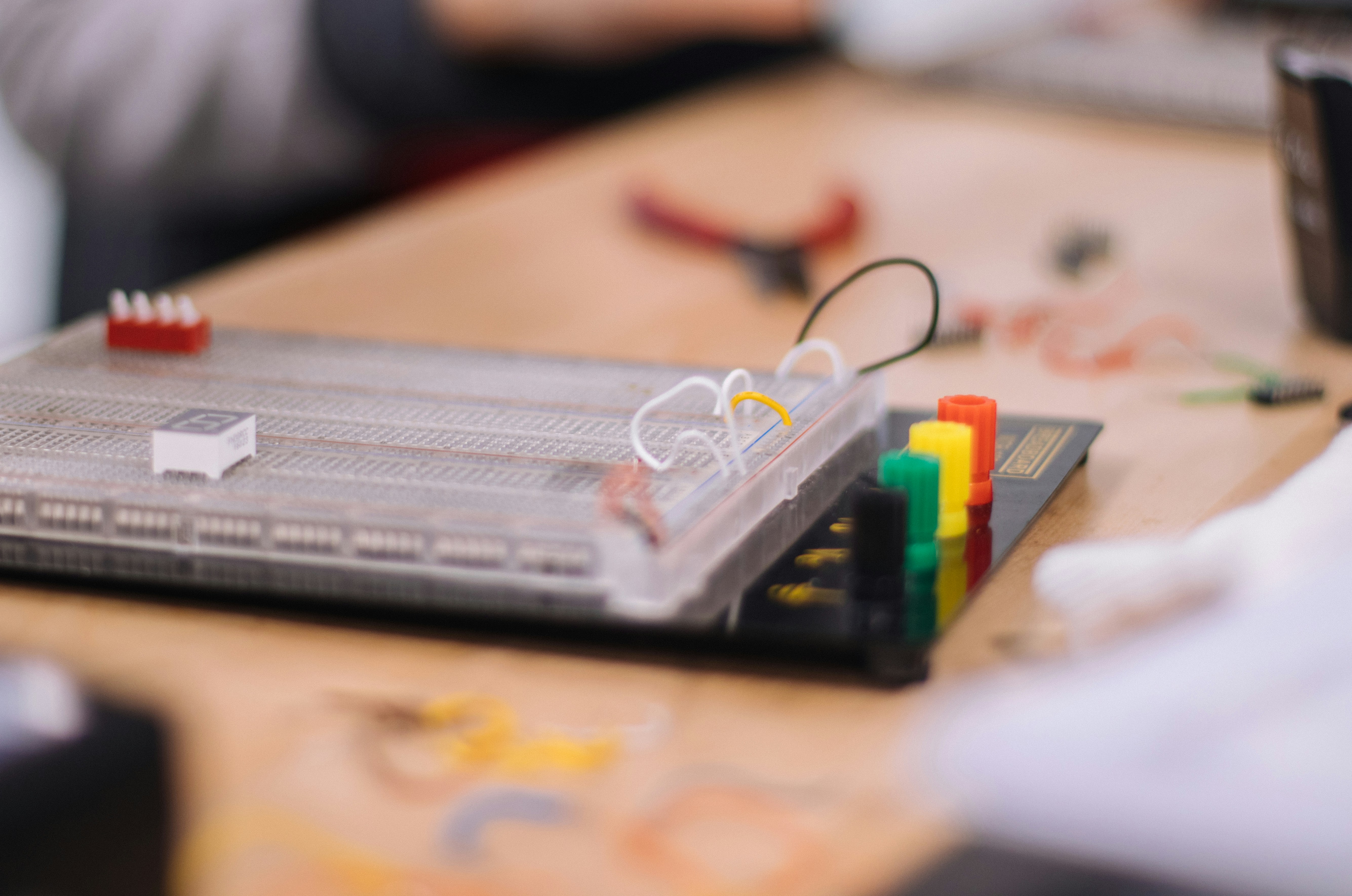

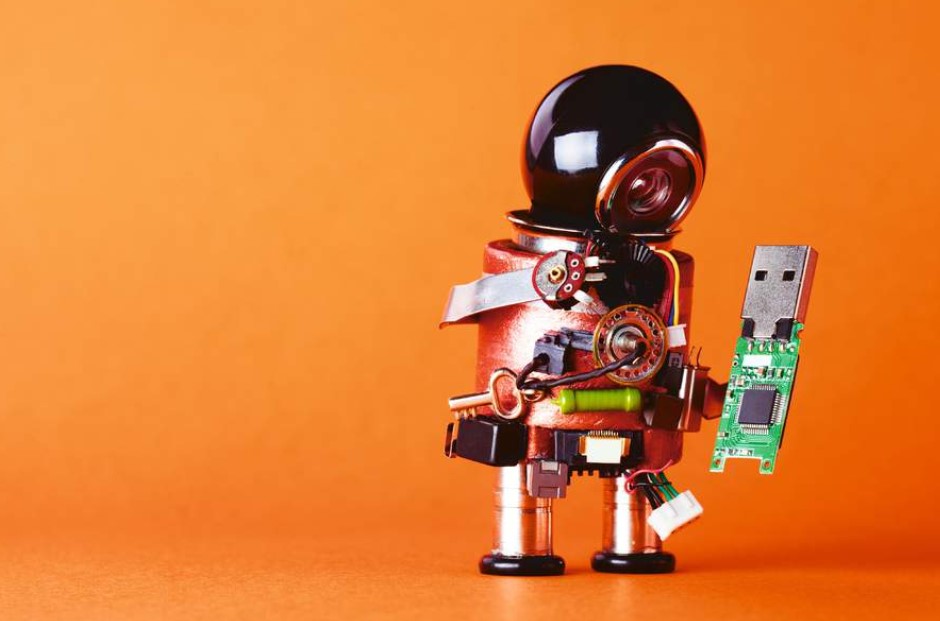



While listening to Shankar Vedantam’s podcast Hidden Brain episode titled “Do Less,” I kept thinking YES! We need to do less in education! We need to stop adding to teachers’ already full plates and start thinking about how subtracting or taking things away might improve our teachers’ and students’ lives.
Vedantam talks with Dr. Leidy Klotz about the power of subtraction. They discuss how removing, streamlining, and simplifying have led to positive change. However, humans have an innate drive to innovate. Innovation often leads to creating more or adding to what already exists. This trend is evident in most school districts and classrooms. School leaders identify priorities and adopt new initiatives without dedicating equal time and energy to identifying things that can be removed or eliminated.
Let’s explore some examples in education where doing less can give teachers and students more.
Teachers are asked to cover a massive amount of content in a school year. There’s pressure to cover course standards, teach the adopted curriculum, keep up with rigid pacing guides, prepare students for standardized exams, and post a particular number of grades in the grade book each week.
This pressure to cover curriculum can make moving away from teacher-led, teacher-paced whole group instruction scary. As a result, teachers spend significant time at the front of the room talking at students instead of allowing students to engage in the messy and often time-consuming work of exploration, meaning-making, and discovery.
Even though most teachers recognize that teacher-led instruction relegates students to a passive and consumptive role and is not the best way to engage learners, they feel trapped by the bombastic pressure to “get through” their curriculum. What is the point of covering content if students don’t understand it and will not remember it?
Teachers need the space to encourage deep learning by engaging students in constructing knowledge through student-centered learning activities where they have more control over their learning experience. Students must do the heavy cognitive lift of asking questions, engaging in conversation, researching and exploring, creatively problem solving, and collaborating around shared tasks.
Asking teachers to cover less would allow them the time and space to explore different instructional models that leverage technology to differentiate and personalize learning, cultivate social-emotional learning skills, and incorporate metacognitive skill-building routines into their classes.
My research identified that the depth and quality of a teacher’s relationships with students significantly impacted their work engagement. Relationships are built through meaningful interactions between the teacher and learner. When students hang out in our rooms at break or lunch and chat informally with us, we get to know them and, often, feel more connected to them because of those interactions. Yet, those teacher-learner interactions can and should be happening daily in the classroom.
So, what stands in the way of human connection in the classroom? Teacher talk. The time teachers spend talking at the front of the room is the biggest barrier to human connection. When facilitating blended learning workshops, I encourage teachers to ask themselves a question before they present information in a mini-lesson or lecture. Are you planning to say the same thing the same way to everyone? If the answer is “Yes,” I encourage them to make a video. Shift that explanation online, allow students to self-pace through it, and use that valuable class time to work directly with small groups or individual learners supporting their specific needs.
The less teachers talk at the front of the room, the more time they can dedicate to tasks like feedback that typically happen outside the classroom. Feedback is how students feel seen and supported, but it is easy to neglect when teachers feel pressure to cover content. Instead, using video strategically and exploring blended learning models, like the station rotation model, can help teachers create the time and space to give timely, focused, and actionable feedback in the classroom as students work. Not only can this lighten a teacher’s workload, but the act of providing real-time feedback can help teachers better understand where students are in their progress and help them develop their relationships with learners.
Too many teachers are spending their evenings and weekends grading. It is exhausting and not a particularly enjoyable task. It’s no wonder so many teachers are frustrated and disillusioned with the profession. They do not enjoy work-life balance because of the massive amount of work they take home.
There is a real fear driving the practice of grading everything. Teachers worry that if there is no grade attached to the work, students will not do it. I understand the rationale, but it’s problematic. Instead of using points and grades as a carrot to entice students to do the work, how can we get students to see the value in their work?
Instead of spending hours grading, I’d love to see teachers invest that time into their design work. Unlike grading, a teacher’s work as the designer of learning experiences is a cognitively engaging task that demands creativity and intentionality.
When I facilitate blended learning workshops, teachers express concern about the time it takes to design student-centered learning experiences with the various models. It’s true that it takes more time to architect a student-centered lesson that invites learners to make meaning as opposed to standing at the front of the room telling students everything we know about a topic. Yet, the time we invest in our design work should free us to spend our precious class time engaging with students and supporting their progress toward learning goals.
Teachers are exhausted and leaving the profession in droves. Hiring and retaining high-quality teachers will demand that schools think about how to make this work more sustainable and rewarding. Continuing to add to our teachers’ workloads will only result in high levels of teacher burnout and attrition from the profession. Instead, school leaders should be asking, what can we remove? How can we give teachers more breathing room and flexibility?
Instead of assuming that the best way to solve every problem is to add something new, it’s time to start tackling issues in education by considering what we might remove or eliminate. Subtracting might be the best solution for re-engaging our teachers and students!
Last month, I delivered a keynote on the future of education. It’s a vast topic, so I focused on four trends likely to impact our work as educators.
As school leaders prepare for the 2022-2023 school year, these four trends can help them identify district priorities and create a strategic plan for the year ahead.
The pandemic pushed teachers and learners online out of necessity. By fall 2020, 69% of districts offered a virtual school option, up from 27% before COVID, and 30% of district leaders, administrators, and teachers expect to see significant growth in blended learning (Arnett, 2021).
Some of the factors contributing to this growth include:
A challenge associated with the increasing growth in blended and online learning is that survey data indicates, “Many current approaches to remote and hybrid instruction aim to replicate the conventional classroom experience online” (Arnett, 2021). However, traditional approaches to instruction fail to maximize the benefits and affordances of the online learning environment. Designing learning experiences for blended or online learning environments demands a high degree of intentionality about what students do synchronously versus asynchronously. To optimize blended learning and online learning, educators need professional development focused on designing student-centered learning experiences that blend active, engaged learning online with active, engaged learning offline.
Teachers are leaving the profession in record numbers due, in part, to the strain of the last three years. When surveyed, 77% of teachers report feeling somewhat or extremely exhausted. 33% of teachers say they are very likely to leave the profession in the next two years, up from 13% before the pandemic (Hanover Research, 2022). Hiring and retaining high-quality teachers will be a challenge for school districts in the upcoming year.
As districts grapple with high levels of teacher turnover, it is essential to understand the connection between work engagement, job satisfaction, and teacher self-efficacy (Granziera & Perera, 2019). Teachers have faced shifting teaching and learning landscapes in the last three years. They transitioned online with little warning and, in many cases, no training to prepare them for teaching online. This negatively impacted their feelings of self-efficacy or their confidence in their ability to do this work well.
The rough transition online and the challenge of engaging students learning in home environments that may not have been conducive to online learning created myriad obstacles for teachers. Student engagement and teacher engagement are reciprocal, so it is not surprising that the lack of student engagement online had a devastating impact on teacher engagement (Roth, Assor, Kanat-Maymon & Kaplan, 2007; Tucker, 2020).
When teachers finally returned to classrooms, they faced new challenges, including concurrent teaching, hybrid schedules, students re-entering schools with trauma, substitute shortages, and fears about contracting COVID. All of this made an already challenging profession more exhausting and stressful.
Attracting and retaining high-quality teachers will require that school districts compensate teachers well for this demanding work. They also need to support teachers in their continued learning and growth with high-quality professional learning opportunities that help them develop high levels of self-efficacy.
As schools reopened, there was a focus on learning loss, and educators felt pressure to make up lost ground and get students “caught up.” Unfortunately, the pressure to address learning loss may have overshadowed the more significant issue of students returning with trauma after two years of social isolation. 49% of students reported feeling “depressed, stressed, or anxious to the point of interfering with their learning.” 71% of teachers said that student morale was lower than before the pandemic (Hanover Research, 2022).
After two years of remote learning, students needed to be reacclimated to an academic learning environment. They needed to feel connected to a supportive learning community where they felt welcomed and safe. Although social-emotional learning (SEL) has been a frequent talking point in education, it needs to be woven into the fabric of our students’ classes.
The CASEL Framework for SEL provides a concrete path for applying evidence-based SEL strategies to our students’ daily lives at school. Educators who focus on integrating SEL skills into their classes can help students manage their emotions, make responsible choices, consider the impact of their behavior on others, and develop healthy relationships. When students develop their SEL skills, they can also take a more active role in their learning, sharing the responsibility for learning with their teachers.
As we approach the 2022-2023 school year, teachers and students will benefit from a focus on SEL, not as an add-on but rather as a skill set integrated into every subject area, to create more robust learning communities and help students develop the skills necessary to thrive in schools and beyond.
Miguel Cardona, the Secretary of Education, said, “While COVID-19 has worsened many inequities in our schools and communities, we know that even before the pandemic, a high-quality education was out of reach for too many of our nation’s students and families.” The pandemic exacerbated existing inequities and has had a disproportionally negative impact on students from underserved communities, including communities of color, multilingual learners, and students with disabilities. Moving forward, Cardona emphasizes the need to “create more culturally and linguistically responsive and inclusive learning environments for all students.”
In the last two years, my focus has been on helping school districts and teachers leverage Universal Design for Learning (UDL) and blended learning to create more accessible, inclusive, and equitable learning experiences for all students.
UDL is a framework grounded in brain-based research and provides “concrete suggestions that can be applied to any discipline or domain to ensure that all learners can access and participate in meaningful, challenging learning opportunities” (CAST, 2022).
While working with Dr. Katie Novak on our book UDL and Blended Learning, we focused on exploring the synergy between these two frameworks. We explore how blended learning models can make implementing UDL more manageable and sustainable.
Universally designed blended learning is grounded in four fundamental beliefs:
The two aspects of education that will not change in the future are 1) learner variability and 2) technology. Given these realities, schools must help teachers understand how to universally design blended learning to honor learner variability and maximize the impact of technology in classrooms.
The summer is a time to reflect, refocus, and prepare for a new year. After the challenges of the last school year, it is critical that school leaders focus on preparing teachers to begin the 2022-2023 school year with the skills they need to design and facilitate equitable learning experiences that integrate SEL and leverage technology to better meet the needs of all learners.
Arnett, T. (2021). Breaking the Mold: How a global pandemic unlocks innovation in K–12 instruction. The Christensen Institute. Retrieved from https://www.christenseninstitute.org/wp-content/uploads/2021/01/BL-Survey-1.07.21.pdf.
CAST. (2022). About Universal Design for Learning. Retrieved from https://www.cast.org/impact/universal-design-for-learning-udl
Collaborative for Academic, Social, and Emotional Learning (CASEL). What Is the CASEL Framework? Retrieved from https://casel.org/fundamentals-of-sel/what-is-the-casel-framework
Granziera, H., & Perera, H. N. (2019). Relations among teachers’ self-efficacy beliefs, engagement, and work satisfaction: A social cognitive view. Contemporary Educational Psychology, 58, 75–84.
Hanover Research. (2022). 2022 Trends in K-12 Education. Retrieved from www.hanoverresearch.com/reports-and-briefs/2022-trends-in-k-12-education
Roth, G., Assor, A., Kanat-Maymon, Y., & Kaplan, H. (2007). Autonomous motivation for teaching: How self-determined teaching may lead to self-determined learning. Journal of Educational Psychology, 99(4), 761–774.
Tucker, C. (2020). Teacher engagement in full-release blended learning courses. [Doctoral dissertation, Pepperdine University]. ProQuest Dissertations & Theses Global.
U.S. Department of Education. (2021). Department of Education Announces Actions to Advance Equity in Education. Retrieved from https://www.ed.gov/news/press-releases/department-education-announces-actions-advance-equity-education
A retrospective, or “look back,” is a strategy that can be used by school leaders, professional learning communities (PLCs), and teachers to engage a group in a structured reflection and brainstorming session. A retrospective can happen any time during the school year (e.g., end of a semester or unit) to encourage a reflective practice, gather feedback, and make adjustments to improve a group’s experience.
A retrospective strives to answer four questions:
The goal of a retrospective is to encourage a group or team to reflect on their work, so they can create an action plan to build on their successes and implement changes for improvement.
If you are a school leader guiding your staff through a retrospective, a coach facilitating a retrospective for a PLC, or an individual teacher using this strategy with your students, you may want to use a digital tool, like Jamboard or Padlet. A virtual platform makes it possible for participants to share their reflections in a digital space where they can see and interact with each other’s ideas. If you are using a Padlet Wall, like the one pictured below, select the column feature to organize responses under each of the four questions. Once participants post their ideas to the virtual wall, they can heart or comment on each other’s virtual post-its.
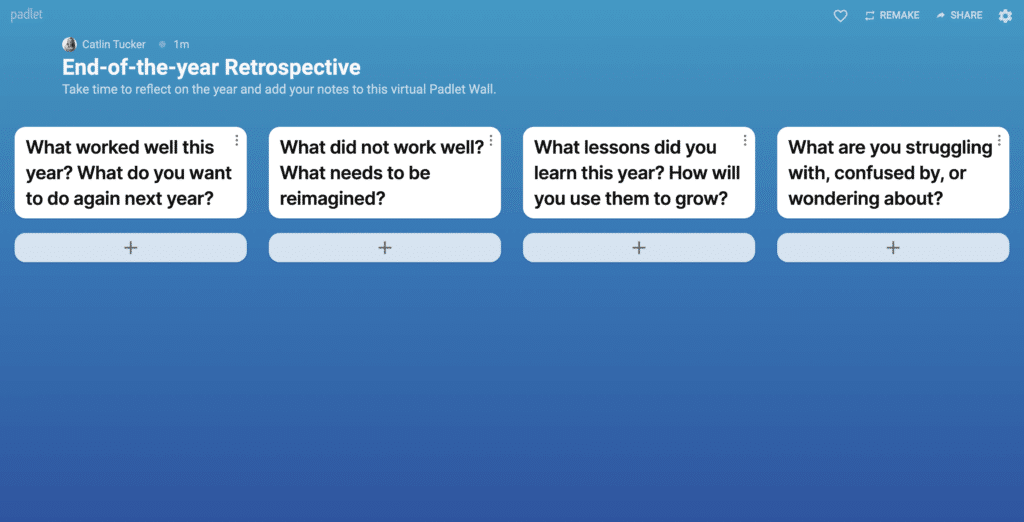
If you prefer Jamboard, I suggest creating a slide for each question to ensure the group’s responses to each question are organized and easy to navigate.
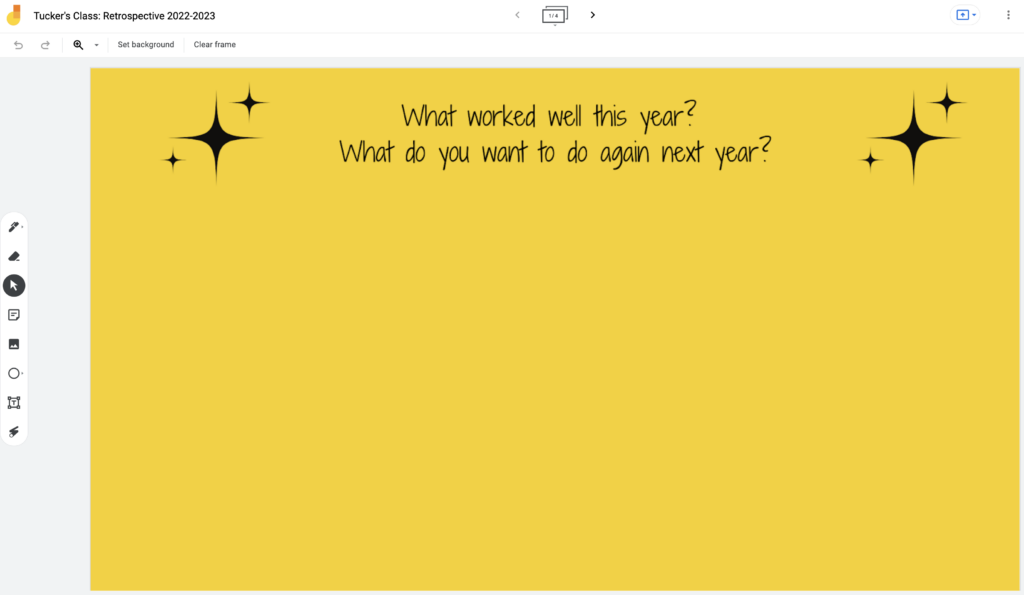
If you prefer to make this a more tactile experience, you can segment a whiteboard into four sections or post each of the four questions in each of the four corners of a room. Then participants can capture their reflections on actual post-it notes and add them to the board or wall.
Once you’ve decided on the strategy you will use to facilitate your retrospective, you will want to follow the steps below to maximize the effectiveness of this activity.
|
Step 1 Reflect & Post |
Review the four questions with your group of teachers or students and give them time to reflect on the year and capture their thoughts on digital or physical post-it notes. Ask the members of your group to post their responses to each question. |
|
Step 2 Silent Gallery Walk |
Once everyone has posted their thoughts, give the group time to do a silent gallery walk of the responses to see what other members of the group had to say in response to each question. |
|
Step 3 Review & Cluster |
As the facilitator, you will want to identify ideas that were repeated by multiple people to identify trends in the responses and cluster similar responses together. |
|
Step 4 Discuss & Brainstorm |
Once you have reviewed the responses with the group and clustered the similar responses, group participants into smaller groups of 3-5 individuals. That way, they can engage in conversation and begin to identify the most important items from the board to create an action plan for next year. Each group should collaborate to identify: 3 things that are working well that the staff or class would like to see continue. 3 things that are working well that the staff or class would like to see continue. 3 things that are not working that need to be reimagined. 3 things that are not working that need to be reimagined. 3 struggles, questions, or wonderings they want to explore further. 3 struggles, questions, or wonderings they want to explore further. |
|
Step 5 Create an Action Plan |
Ask each group to spend time discussing and brainstorming solutions they think can help the group reimagine the three things that are not working. Encourage each group to collaborate to come up with creative solutions! |
As groups discuss the aspects of their work or their experience that did not go well, encourage them to capture their ideas on an action plan document, like the one pictured below. Ask them to brainstorm ways they think this thing could be reimaged and challenge them to identify what would be needed to make those changes (e.g., resources, a shift in mindset) and how they would measure success as this change is implemented.
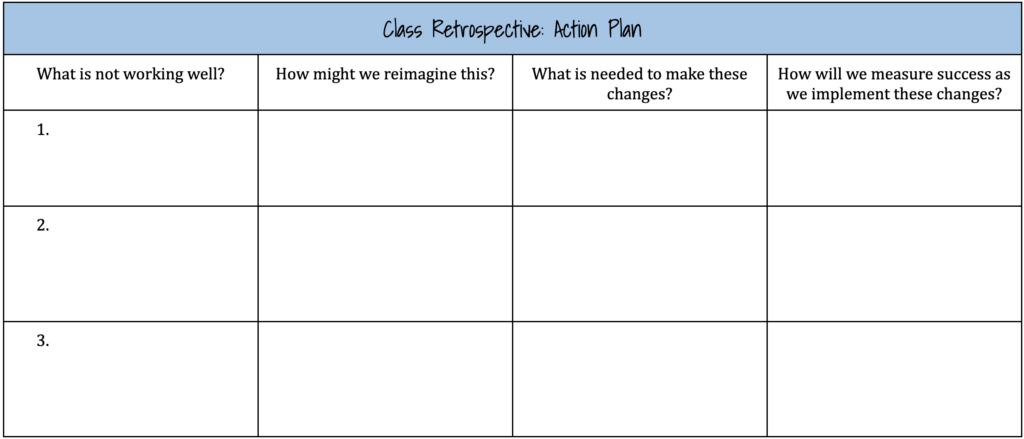
The beauty of this final step is that the school leader, coach, or teacher facilitating the retrospective can tap into the collective intelligence of the group to generate ideas for how to improve everyone’s experience moving forward. The ideas generated during the retrospective can be captured, saved, and then referenced at the end of summer as school leaders, coaches, and teachers prepare for a new school year!
 Calling all coaches!
Calling all coaches! 
“This was an excellent learning experience for me. As a coach and as a PD leader, I took away many concrete examples that I can use with my staff.”
Who is this course for?
What can you expect from this course?